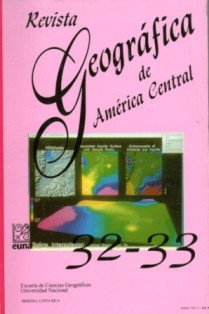USO DEL SUELO Y FRONTERA AGRICOLA EN EL SUDESTE DE NICARAGUA. EJEMPLO DE INTEGRACIÓN DE LOS SISTEMAS DE POSICIONAMIENTO GLOBAL, LOS SISTEMAS DE INFORMACION GEOGRAFICA Y LA TELEDETECCIÓN
Abstract
Este articulo tal como reza en su titulo, reúne la aplicación de tres tecnologías diferentes en la geografía actual: Sistemas de Posicionamiento Global (SPG), Sistemas de Información Geográfica (SIG) y Teledetección, lo cual es importante para los investigadores de estos temas y para el lector común científico o no. Pero la principal finalidad del trabajo es que sus contenidos rigurosos, metodológica y teóricamente tratan de análisis histórico del uso de los recursos naturales y la evolución ecológica en uno de los países mas devastados por todo tipo de calamidad: los desastres naturales, los desastres sociales-guerra- y las enfermedades. Lo anterior lo califica como uno de los países más pobres de Centroamérica y del mundo.
El sudeste de Nicaragua es la <<muestra>> de nuestros países expoliados, exportadores de materia prima, endeudados con los entes financieros y con todo tipo de debilidad interna: desempleo, bajos salarios, desigualdad en la repartición de la tierra, dominio empresarial de una <<oligarquía>>, agricultura de subsistencia, factores ambientales negativos. Como se señalará más adelante, <<a los habitantes les gusta decir que llueve trece meses al año>>.
Este último factor, constituye una dificultad metodológica porque la cantidad de nubosidad impide realizar trabajos <<óptimos>>. No obstante, el trabajo deja ver las consecuencias de la deforestación para el pastoreo y algunos cultivos (monocultivos y productos para el mercado externo).
En conclusión, el estudio lleva a la consecución de la distribución del uso del suelo, la delimitación de la frontera agrícola y la elaboración del mapa respectivo para 1992, elementos que permiten comparar el gran avance de la frontera agrícola observando un mapa del instituto Nicaragüense de Estudios Territoriales (INETER) de 1983.
ABSTRACT
This article focuses on the application of Global Positioning Systems (GPS), Geographical Information Systems (GIS), and Remote Sensing to the study of the agricultural frontier of Southeastern Nicaragua in the elaboration of a land use map of this area. The methodology of map elaboration, bases on LANDSAT satellite imagines, is explained. A report on deforestation processes and the agrarian frontier in Nicaragua within the context of Central America is also included.
Downloads
How to Cite
Issue
Section
License
Proposed policy for journals offering Open Access
Authors publishing their works in the Journal acknowledge and agree to the following terms:
a) Authors retain the copyrights to their works and guarantee the Journal the right to be the first to publish their works, under the Creative Commons License Attribution-NonCommercial-ShareAlike 4.0 International, CC BY-NC-SA 4.0 International (https://creativecommons.org/licenses/by-nc-sa/4.0/deed.es), which allows others to share works upon complying with the acknowledgment of authorship and mention of the Journal as the original publisher of the work.
b) Authors are permitted to separately establish additional agreements for the non-exclusive distribution of the official edition of the work published in the Journal (for example, authors may desire to place the work in an institutional repository or incorporate it into a book that is to published elsewhere) so long they acknowledgment to recognize the Journal as the original publisher. The aforementioned additional agreements must respect the terms of the non-profit character and sharing philosophy of the original license (CC BY-NC-SA 4.0 International, https://creativecommons.org/licenses/by-nc-sa/4.0/deed.es).
c) Authors are encouraged to archive the post-print or editor/PDF version in Open Access repositories.






 REVGEO is licensed under https://creativecommons.org/licenses/by-nc-sa/4.0/deed.es
REVGEO is licensed under https://creativecommons.org/licenses/by-nc-sa/4.0/deed.es
.svg_4.png)

_(1).png)
_(1)_(1)_(1)_1.png)
(2)(1)(1)(1).png)
